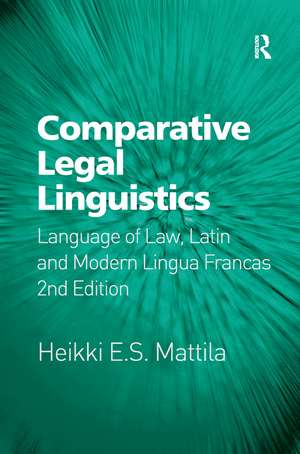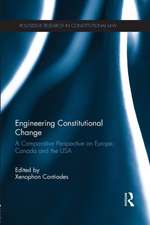Comparative Legal Linguistics: Language of Law, Latin and Modern Lingua Francas
Autor Heikki E. S. Mattilaen Limba Engleză Paperback – 11 noi 2016
| Toate formatele și edițiile | Preț | Express |
|---|---|---|
| Paperback (1) | 489.26 lei 6-8 săpt. | |
| Taylor & Francis – 11 noi 2016 | 489.26 lei 6-8 săpt. | |
| Hardback (1) | 1130.23 lei 6-8 săpt. | |
| Taylor & Francis – 10 ian 2013 | 1130.23 lei 6-8 săpt. |
Preț: 489.26 lei
Nou
Puncte Express: 734
Preț estimativ în valută:
93.63€ • 96.73$ • 77.93£
93.63€ • 96.73$ • 77.93£
Carte tipărită la comandă
Livrare economică 26 martie-09 aprilie
Preluare comenzi: 021 569.72.76
Specificații
ISBN-13: 9781138255593
ISBN-10: 1138255599
Pagini: 504
Dimensiuni: 156 x 234 x 32 mm
Greutate: 0.45 kg
Ediția:Revised
Editura: Taylor & Francis
Colecția Routledge
Locul publicării:Oxford, United Kingdom
ISBN-10: 1138255599
Pagini: 504
Dimensiuni: 156 x 234 x 32 mm
Greutate: 0.45 kg
Ediția:Revised
Editura: Taylor & Francis
Colecția Routledge
Locul publicării:Oxford, United Kingdom
Notă biografică
Professor Heikki E.S. Mattila is Professor Emeritus of Legal Linguistics at the University of Lapland, Finland. His current research interests focus on comparative law and comparative legal linguistics. He has published several studies on legal languages, especially on legal Latin, as well as on family law, law of inheritance and international private law. Professor Mattila is also Docent of Comparative Law at the University of Helsinki in Finland.
Recenzii
Reviews for the first edition: ’Mattila's fascination with the law is well conveyed through clear articulation of the structures and processes underpinning various legal systems...this is an excellent book for advanced undergraduates and postgraduates working in any field related to language and the law.’ Annabelle Mooney, International Journal for the Semiotics of Law ’This exceptional book constitutes a fine source of learning for comparative lawyers, lawmakers (especially European lawmakers), linguists and historians but also a great inspiration for legal practitioners and legal translators and interpreters who are willing to look beyond the confines of their own legal system.’ Franz J. Heidinger, Translatio (FIT) ’Mattila proves in his work that comparative legal studies can be fruitfully approached from the linguistic point of view...The emerging global law will need a new language and works like Mattila's are fundamental to its development.’ Marcus Galdia, The European Legal Forum ’This admirable tome reveals and analyses the common synchronic and diachronic features of legal languages. Its scope is wide, encompassing the two major legal systems and four major legal languages - the entirety suffused with examples, linguistic and legal, sourced in numerous other languages. The author displays a rare mastery of both the legal and linguistic sides of his subject.’ MáirtÃn Mac Aodha, Meta:Translators' Journal Reviews for the second edition: '... It is dense (in the nicestpossible sense) and comprehensive: both the writing and the translation of such a detailed, precise and thorough work cannot fail to impress. ... Mattila's masterpiece doubtless does deserve the attention of anyone concerned with the role of language in practising law, interested in comparing international and national legal systems, or motivated to explore linguistics in a range of contexts, from law to politics.' Clarity '... as far as one can see, Mattila's work is the o
Cuprins
Preface PART 1: GENERAL INTRODUCTION 1 Legal Language and Legal Linguistics PART 2: LEGAL LANGUAGE AS A LANGUAGE FOR SPECIAL PURPOSES 2 Functions of Legal Language 6 Legal German 3 Characteristics of Legal Language 4 Legal Terminology PART 3: THE MAJOR LEGAL LANGUAGES 5 The Heritage of Legal Latin 7 Legal French 8 Legal Spanish 9 Legal English PART 4: CONCLUSION 10 Lexical Comprehension and Research Needs
Descriere
This book examines legal language as a language for special purposes, evaluating the functions and characteristics of legal language and the terminology of law. Using examples drawn from major and lesser legal languages, it examines the major legal languages themselves, beginning with Latin through German, French, Spanish and English. The work is a valuable resource for students, researchers and practitioners in the areas of legal history and theory, comparative law, semiotics, and linguistics. It is also of interest to legal translators and terminologists.







